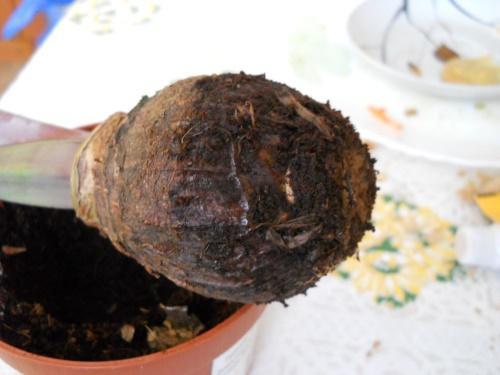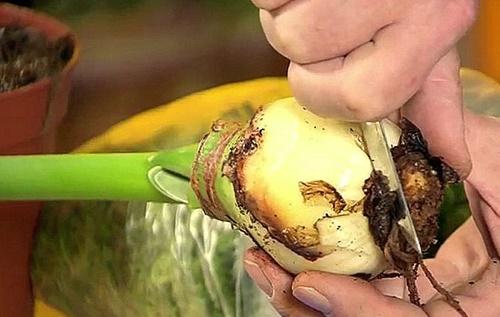What to do if the hippeastrum is without roots: we revive and help the bulb to recover
 Hippeastrum is grown by many growers for their gorgeous bloom. This is a rather unpretentious flower that can grow even in the garden in the summer, but sometimes trouble happens to it. One of the questions that worries amaryllis lovers: what to do if hippeastrum is without roots? It would seem that any other plant has long disappeared, but this flower has extraordinary vitality. Even in this state, it continues to develop and disappears only in especially advanced cases.
Hippeastrum is grown by many growers for their gorgeous bloom. This is a rather unpretentious flower that can grow even in the garden in the summer, but sometimes trouble happens to it. One of the questions that worries amaryllis lovers: what to do if hippeastrum is without roots? It would seem that any other plant has long disappeared, but this flower has extraordinary vitality. Even in this state, it continues to develop and disappears only in especially advanced cases.
Reasons why a bulb can lose roots

In "domestic" amaryllis, which are already growing in pots, the roots may disappear after rest or as a result of illness. Moreover, it is difficult to notice this, because for a long time the plant continues to release leaves and even bloom without roots. But over time, the supply of nutrients in the bulb is depleted. She does not receive new nutrition and the plant may die, especially from the fungus. But if you remove the lesions, everything will work out.
What to do if hippeastrum is without roots: step by step instructions
So, as it has already become clear, there is nothing wrong with the fact that the onion remained "deprived", and everything can be corrected. Further actions depend on the state in which it is:
- The first step is to carefully clean the onion from dry scales, removing everything until it turns white and beautiful. If at the same time it becomes noticeable that the scales are soft, but clean, without spots, you do not need to remove such. After resting, the hippeastrum often loses its elasticity, but the turgor will return again.

- If the roots have rotted or, even worse, rot appears on the bottom and sides, additional processing will be needed. All rotten parts should be cut out and covered with dry powder Fitosporin... After that, it is important to give time for the bulb to dry (24 hours) and put it on rooting.

If there is no dry powder, it can be etched in a solution of potassium permanganate or Maxim. Cover the sections with charcoal or activated carbon.
The opinions of flower growers differ regarding rooting. Some people believe that it is better to do this in sand or vermiculite, or immediately in the soil, adding a sand pillow under the bottom. It is noteworthy that it is impossible to completely plant the hippeastrum - at first it is enough to slightly deepen the bottom. And when the roots appear, you can either fill up the soil, or plant the flower in a permanent place in a pot with a substrate. This option is most often used for rot-damaged bulbs.Healthy specimens can be rooted in a jar of water by adding 5 drops of Zircon (per 1 tbsp.) To it. Again, you do not need to completely immerse in water - the bulb should only touch it with its bottom.
In general, hippeastrum quickly grows new roots, even in case of decay. The main thing is not to flood the plant during this period, but maintain constant humidity all the time.